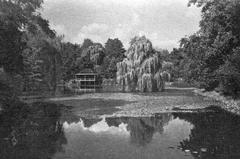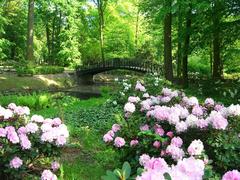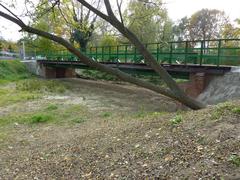
Szczytnicki Park Wrocław: Visiting Hours, Tickets, History & Attractions Guide
Date: 14/06/2025
Introduction
Szczytnicki Park is among Wrocław’s most iconic green spaces—an expansive, historic, and ecologically rich urban park that has evolved over centuries into a cultural and natural landmark. Spanning over 100 hectares, Szczytnicki Park seamlessly blends tranquil landscapes, architectural marvels, and vibrant community life. Whether you are seeking a peaceful stroll, a deep dive into history, or family-friendly recreation, this detailed guide covers everything you need to know, from visiting hours and ticketing to main attractions, accessibility, and travel tips.
Table of Contents
- Introduction
- Historical Overview
- Cultural & Architectural Highlights
- Ecological Significance
- Visiting Information
- Major Attractions
- Travel Tips & Photography
- FAQ
- Conclusion & Call to Action
- References
Historical Overview
Early Development
Szczytnicki Park’s origins trace back to 1783 when Ludwig von Hohenlohe established the first English-style landscape park in Wrocław on the grounds of the former village of Szczytniki. Initially covering 16 hectares, this “princely park” rapidly became a favorite retreat for its picturesque natural scenery (visitwroclaw.eu).
19th-Century Expansion
After suffering neglect following Napoleonic conflicts, the park was rejuvenated and expanded during the 19th century. Influential Berlin gardener Peter Joseph Lenné introduced sweeping English landscape design principles, incorporating native and exotic flora, winding paths, and water features. By the mid-1800s, Szczytnicki Park had grown significantly, featuring a horse racing track and areas dedicated to flood control (halastulecia.pl).
Cultural Flourishing & Exhibitions
The early 20th century marked a cultural renaissance for the park. For the 1913 Centennial Exhibition, several now-iconic structures were added, including the monumental Centennial Hall (now a UNESCO World Heritage Site), the Pergola, the Pavilion of Four Domes, and the Japanese Garden. The relocation of the 17th-century wooden Church of St. John of Nepomuk further enriched the park’s historical tapestry (Wikipedia).
Wartime & Postwar Transformations
World War II inflicted significant damage, but postwar efforts focused on restoration and conservation. Notably, the Japanese Garden was painstakingly restored in the 1990s with the expertise of Japanese landscape architects, reviving its authentic character (przyrodniczo.pl).
Cultural & Architectural Highlights
- Centennial Hall (Hala Stulecia): Designed by Max Berg in 1913, Centennial Hall is celebrated for its pioneering reinforced concrete architecture and impressive dome. It serves as a venue for exhibitions, concerts, and sporting events (thecrazytourist.com).
- Pergola & Multimedia Fountain: This semi-circular walkway, adorned with climbing plants, encircles one of Poland’s largest multimedia fountains, known for its spectacular water, light, and music shows during the summer (visitwroclaw.eu).
- Japanese Garden: Created for the 1913 exhibition and restored with Japanese collaboration, this garden is a rare example of authentic Japanese landscaping in Central Europe (visitwroclaw.eu).
- Wooden Church of St. John of Nepomuk: This historical, 17th-century church, relocated from Stare Koźle, exemplifies traditional Silesian architecture.
Ecological Significance
Biodiversity & Fauna
Szczytnicki Park is often regarded as Poland’s largest open-air arboretum, home to over 450 species of trees and shrubs from Europe, Asia, and the Americas. Notable species include ancient oaks, ginkgo, tulip trees, rhododendrons, and rare orchids. The park’s ponds and woodlands provide sanctuary for squirrels, hedgehogs, foxes, roe deer, martens, and diverse birdlife, making it a haven for nature lovers and birdwatchers (zzm.wroc.pl).
Conservation & Sustainability
Since 1997, Szczytnicki Park has been part of a protected nature and landscape complex. Restoration projects continue to revive its English landscape heritage and expand green areas, while educational programs promote conservation and sustainable urban living (gazetawroclawska.pl).
Visiting Information
Hours & Admission
- Park Grounds: Open daily, year-round, from 6:00 AM to 10:00 PM.
- Entry: Free admission to Szczytnicki Park.
- Japanese Garden: Open April–October, typically 9:00 AM–7:00 PM. Tickets: ~15 PLN (regular), 10 PLN (reduced), 40 PLN (family).
- Centennial Hall: Exterior is freely accessible; ticket required for exhibitions and events.
- Multimedia Fountain: Shows are free, running May–September, with evening performances on weekends (visitwroclaw.eu).
Accessibility
The park is wheelchair- and stroller-friendly, with flat, well-maintained paths and accessible facilities near main entrances. Most attractions, including the Japanese Garden and Centennial Hall, offer ramps and accessible restrooms.
Facilities
- Restrooms near main attractions
- Benches, gazebos, and picnic areas
- Playgrounds and open lawns
- Seasonal cafés and food stalls
Getting There
- Public Transport: Trams 2, 4, 10, and 33 stop near the park; journey from city center takes about 15–20 minutes (DestGuides).
- Parking: Available near Centennial Hall and other entrances; spaces limited during events.
- Cycling: Dedicated bike paths connect the park to other parts of Wrocław.
Major Attractions
- Japanese Garden: A tranquil, meticulously landscaped space featuring koi ponds, bridges, and traditional Japanese horticulture.
- Centennial Hall & Pergola: Architectural marvels and venues for cultural events and multimedia fountain shows.
- Wooden Church of St. John of Nepomuk: A historic, atmospheric retreat.
- Botanical Diversity: Over 450 species of trees and shrubs, colorful flower beds, and rare plant species.
- Wildlife Observation: Birdwatching, small mammals, and serene natural habitats.
- Family-Friendly Areas: Modern playgrounds, wide lawns, and picnic spots.
Travel Tips & Photography
- Best Visiting Times: Spring and early summer for blooms; summer evenings for fountain shows; early mornings for tranquility.
- Photo Hotspots: Japanese Garden, Pergola, Centennial Hall, and natural vistas.
- Essentials: Comfortable shoes, water, picnic supplies, and a camera.
- Regulations: Dogs allowed on leash; cycling and skating on designated paths; keep the park clean and respect wildlife.
FAQ
Q: What are Szczytnicki Park’s opening hours?
A: The park is open daily from 6:00 AM to 10:00 PM.
Q: Is there an entry fee?
A: Entry to the park is free; some attractions like the Japanese Garden require tickets.
Q: Are pets allowed?
A: Yes, dogs must be leashed and owners must clean up after them.
Q: Is the park accessible for wheelchairs and strollers?
A: Yes, most paths and facilities are accessible.
Q: When are Multimedia Fountain shows held?
A: From May to September, with evening shows on weekends.
Conclusion & Call to Action
Szczytnicki Park is more than a green oasis—it’s a living symbol of Wrocław’s evolving history, culture, and ecological commitment. With free entry, a wealth of attractions, and convenient amenities, it’s a welcoming space for all—families, tourists, locals, and nature enthusiasts alike. Plan your visit around seasonal highlights, explore with guided tours, and use the Audiala app for personalized itineraries and up-to-date event information.
Connect with Wrocław’s heritage and enjoy one of Poland’s finest urban parks. For more inspiration, follow official social channels and check local tourism sites for event updates and visitor tips.
References
- Szczytnicki Park Wrocław: Visiting Hours, Tickets, History, and Travel Tips, 2024
- Discover Szczytnicki Park Wrocław: Your Ultimate Guide to Visiting Hours, Tickets, History, and Ecology, 2024
- Szczytnicki Park Wrocław: Visiting Hours, Tickets & Top Attractions, 2024
- Szczytnicki Park Visiting Hours, Tickets, and Attractions in Wrocław: Your Complete Guide, 2024
- Szczytnicki Park Official Site and Nature Complex Information, 2024
- Przyrodniczo.pl: Szczytnicki Park Biodiversity Details, 2024
- Centennial Hall UNESCO World Heritage Information, 2024
- Audiala App for Wrocław Travel Guides, 2024
For more guides and updates on Wrocław’s best parks and attractions, browse our related articles and stay connected through our social channels.















































